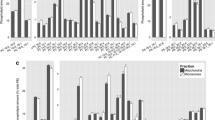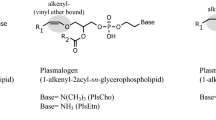Abstract
One of the biggest risk factors for developing Alzheimer’s disease is advanced age. Despite several studies examining changes to phospholipids in the hippocampus during the pathogenesis of Alzheimer’s disease, little is known regarding changes to phospholipids in this region during normal adult aging. This study examined the phospholipid composition of the mitochondrial and microsomal membranes of the human hippocampus from post-mortem tissue of neurologically normal subjects aged between 18 and 104 years. Many of the age-related changes found were in low-to-moderately abundant phospholipids in both membrane fractions, with decreases with age being seen in many phospholipids containing either adrenic or arachidonic acid. The most abundant phospholipid of this type was phosphatidylethanolamine 18:0_22:4, which decreased in both the mitochondrial and microsomal membranes by approximately 20 % from ages 20 to 100. Subsequent decreases with age were seen in total adrenic and arachidonic acid in the phospholipids of both membrane fractions, but not in either fatty acid specifically within the phosphatidylethanolamine class. Increases with age were seen in the hippocampus for mitochondrial phosphatidylserine 18:0_22:6. This is the first report of changes to molecular phospholipids of the human hippocampus over the adult lifespan, with this study also providing a comprehensive profile of the phosphatidylcholine, phosphatidylethanolamine and phosphatidylserine phospholipids of the human hippocampus.








Similar content being viewed by others
Abbreviations
- AD:
-
Alzheimer’s disease
- ARA:
-
Arachidonic acid
- DHA:
-
Docosahexaenoic acid
- ChoGpl:
-
Choline glycerophospholipids
- EtnGpl:
-
Ethanolamine glycerophospholipids
- PakCho:
-
Plasmanyl phosphatidylcholine
- PakEtn:
-
Plasmanyl phosphatidylethanolamine
- PlsEtn:
-
Plasmenyl phosphatidylethanolamine (ethanolamine plasmalogen)
- PtdCho:
-
Phosphatidylcholine
- PtdEtn:
-
Phosphatidylethanolamine
- PtdSer:
-
Phosphatidylserine
- PUFA:
-
Polyunsaturated fatty acid(s)
References
WHO, Alzheimer’s Disease International (2012) Dementia: a public health priority. In: WHO. http://www.who.int/mental_health/publications/dementia_report_2012/en/. Accessed 12 Feb 2014
Kosicek M, Hecimovic S (2013) Phospholipids and Alzheimer’s disease: alterations, mechanisms and potential biomarkers. Int J Mol Sci 14:1310–1322. doi:10.3390/ijms14011310
Mapstone M, Cheema AK, Fiandaca MS et al. (2014) Plasma phospholipids identify antecedent memory impairment in older adults. Nat Med 20:415–418. doi:10.1038/nm.3466
Fox NC, Crum WR, Scahill RI et al (2001) Imaging of onset and progression of Alzheimer’s disease with voxel-compression mapping of serial magnetic resonance images. The Lancet 358:201–205. doi:10.1016/S0140-6736(01)05408-3
Scahill RI, Schott JM, Stevens JM et al (2002) Mapping the evolution of regional atrophy in Alzheimer’s disease: unbiased analysis of fluid-registered serial MRI. Proc Natl Acad Sci 99:4703–4707. doi:10.1073/pnas.052587399
Scahill RI, Frost C, Jenkins R et al (2003) A longitudinal study of brain volume changes in normal aging using serial registered magnetic resonance imaging. Arch Neurol 60:989–994. doi:10.1001/archneur.60.7.989
Ewers M, Insel P, Jagust WJ et al. (2012) CSF biomarker and PIB-PET–derived beta-amyloid signature predicts metabolic, gray matter, and cognitive changes in nondemented subjects. Cereb Cortex 22:1993–2004. doi:10.1093/cercor/bhr271
Braak H, Braak E (1991) Neuropathological staging of Alzheimer-related changes. Acta Neuropathol Berl 82:239–259
Corrigan FM, Horrobin DF, Skinner ER et al (1998) Abnormal content of n-6 and n-3 long-chain unsaturated fatty acids in the phosphoglycerides and cholesterol esters of parahippocampal cortex from Alzheimer’s disease patients and its relationship to acetyl CoA content. Int J Biochem Cell Biol 30:197–207
Guan Z, Wang Y, Cairns NJ et al (1999) Decrease and structural modifications of phosphatidylethanolamine plasmalogen in the brain with Alzheimer disease. J Neuropathol Exp Neurol 58:740–747
Prasad MR, Lovell MA, Yatin M et al (1998) Regional membrane phospholipid alterations in Alzheimer’s disease. Neurochem Res 23:81–88
Skinner ER, Watt C, Besson JAO, Best PV (1993) Differences in the fatty acid composition of the grey and white matter of different regions of the brains of patients with Alzheimer’s disease and control subjects. Brain 116:717–725. doi:10.1093/brain/116.3.717
Söderberg M, Edlund C, Alafuzoff I et al (1992) Lipid composition in different regions of the brain in Alzheimer’s disease/senile dementia of Alzheimer’s type. J Neurochem 59:1646–1653
Wells K, Farooqui AA, Liss L, Horrocks LA (1995) Neural membrane phospholipids in Alzheimer disease. Neurochem Res 20:1329–1333. doi:10.1007/BF00992508
Söderberg M, Edlund C, Kristensson K, Dallner G (1991) Fatty acid composition of brain phospholipids in aging and in Alzheimer’s disease. Lipids 26:421–425
Söderberg M, Edlund C, Kristensson K, Dallner G (1990) Lipid compositions of different regions of the human brain during aging. J Neurochem 54:415–423
O’Brien JS, Sampson EL (1965) Lipid composition of the normal human brain: gray matter, white matter, and myelin. J Lipid Res 6:537–544
Yetukuri L, Ekroos K, Vidal-Puig A, Orešič M (2008) Informatics and computational strategies for the study of lipids. Mol BioSyst 4:121–127. doi:10.1039/B715468B
Svennerholm L (1968) Distribution and fatty acid composition of phosphoglycerides in normal human brain. J Lipid Res 9:570–579
Martínez M, Mougan I (1998) Fatty acid composition of human brain phospholipids during normal development. J Neurochem 71:2528–2533. doi:10.1046/j.1471-4159.1998.71062528.x
Blanksby SJ, Mitchell TW (2010) Advances in mass spectrometry for lipidomics. Annu Rev Anal Chem Palo Alto Calif 3:433–465. doi:10.1146/annurev.anchem.111808.073705
Norris SE, Friedrich MG, Mitchell TW et al (2015) Human prefrontal cortex phospholipids containing docosahexaenoic acid increase during normal adult aging, whereas those containing arachidonic acid decrease. Neurobiol Aging 36:1659–1669. doi:10.1016/j.neurobiolaging.2015.01.002
Liebisch G, Vizcaíno JA, Köfeler H et al (2013) Shorthand notation for lipid structures derived from mass spectrometry. J Lipid Res 54:1523–1530. doi:10.1194/jlr.M033506
Sprecher H (2000) Metabolism of highly unsaturated n-3 and n-6 fatty acids. Biochim Biophys Acta BBA Mol Cell Biol Lipids 1486:219–231. doi:10.1016/S1388-1981(00)00077-9
Brooksbank BW, Martinez M (1989) Lipid abnormalities in the brain in adult Down’s syndrome and Alzheimer’s disease. Mol Chem Neuropathol Spons Int Soc Neurochem World Fed Neurol Res Groups Neurochem Cerebrospinal Fluid 11:157–185
Fraser T, Tayler H, Love S (2010) Fatty acid composition of frontal, temporal and parietal neocortex in the normal human brain and in Alzheimer’s disease. Neurochem Res 35:503–513. doi:10.1007/s11064-009-0087-5
Baylis D, Bartlett DB, Patel HP, Roberts HC (2013) Understanding how we age: insights into inflammaging. Longev Heal 2:8. doi:10.1186/2046-2395-2-8
Kim H-Y, Akbar M, Kim Y-S (2010) Phosphatidylserine-dependent neuroprotective signaling promoted by docosahexaenoic acid. Prostaglandins Leukot Essent Fat Acids PLEFA 82:165–172. doi:10.1016/j.plefa.2010.02.025
Martinez M (1992) Abnormal profiles of polyunsaturated fatty acids in the brain, liver, kidney and retina of patients with peroxisomal disorders. Brain Res 583:171–182. doi:10.1016/S0006-8993(10)80021-6
Hassan-Zadeh E, Baykal-Caglar E, Alwarawrah M, Huang J (2014) Complex roles of hybrid lipids in the composition, order, and size of lipid membrane domains. Langmuir 30:1361–1369. doi:10.1021/la4044733
Klose C, Surma MA, Simons K (2013) Organellar lipidomics—background and perspectives. Curr Opin Cell Biol 25:406–413. doi:10.1016/j.ceb.2013.03.005
Szekely O, Schilt Y, Steiner A, Raviv U (2011) Regulating the size and stabilization of lipid raft-like domains and using calcium ions as their probe. Langmuir 27:14767–14775. doi:10.1021/la203074q
Acknowledgments
We gratefully acknowledge technical assistance with tissue preparation from Dr. Surabhi Bhatia, Mrs. Kalani Ruberu, Dr. Sarah Abbott and Mrs. Amanda Skora. Human brain tissue was received from the New South Wales Tissue Resource Centre at the University of Sydney, which is supported by the National Health and Medical Research Council of Australia, Schizophrenia Research Institute and the National Institute of Alcohol Abuse and Alcoholism (NIH (NIAAA) R24AA012725). The present research was supported by a grant from the National Health and Medical Research Council of Australia (1008667). TWM is supported by an ARC Future Fellowship (FT110100249).
Author information
Authors and Affiliations
Corresponding author
Electronic supplementary material
Below is the link to the electronic supplementary material.
About this article
Cite this article
Hancock, S.E., Friedrich, M.G., Mitchell, T.W. et al. Decreases in Phospholipids Containing Adrenic and Arachidonic Acids Occur in the Human Hippocampus over the Adult Lifespan. Lipids 50, 861–872 (2015). https://doi.org/10.1007/s11745-015-4030-z
Received:
Accepted:
Published:
Issue Date:
DOI: https://doi.org/10.1007/s11745-015-4030-z




